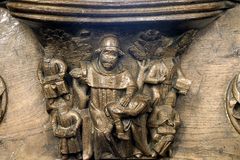Misericord
A misericord (sometimes named mercy seat) is a small wooden shelf on the underside of a folding seat in a church, installed to provide a degree of comfort for a person who has to stand during long periods of prayer. When the seat is folded up, the user can lean against it and the misericord slightly reduces their discomfort. Like most other medieval woodwork in churches, misericords were usually skilfully carved and often show detailed scenes, despite being hidden underneath the seats, especially in the choir stalls of the quire around the altar.
Misericords may or may not have supporters. These are carved structures to the left and right of the main motif.
For research purposes, the misericords of a church are identified by a letter N or S (north or south) followed by further letters, if needed, followed by a number.
Spanking scenes on medieval misericords
The following examples of carved school corporal punishment scenes from misericords are known.
- Example 1: from St Botolph's Church in Boston, Lincolnshire, England. In one misericord from 1390, a novice or schoolboy is laid over the laps of other students, with his head resting in the schoolmaster's lap, and is trying to protect his buttocks with a book.
- Example 2: from the Abbey Church of St. Mary the Virgin at Sherborne, Dorset, England. This example is very similar to the one in Boston. It also features three other students, holding books, witnessing the punishment, with a seated birch-wielding teacher. But this one shows the classic OTK position and is probably from the 15th century.
- Example 3: from Norwich Cathedral, Norfolk, England. In one misericord, a schoolmaster is birching a school boy OTK, bare bottomed, surrounded by four boys reading books (image, image, image). In three other misericords, apes are depicted birching or being birched. These misericords are from 1480.
- Example 4: from the church of the Royal Monastery of Brou at Bourg-en-Bresse, Ain, France. It is from the 16th century. Here, the spankee is apparently a monk or novice, kneeling or on all fours. His cowl is raised to expose him from the waist down. The implement appears to be a kind of scourge. Some web pages (example) call the spankee a "young woman", but the identification of a female in this carving from a monastery is questionable.
- Example 5: from Saint-Bertrand-de-Comminges Cathedral, France. Choir stall arm rests from the 16th century depict schoolboys being birched.
Findings
None of these misericords depict a disciplina supra (whipping of the back). All known examples depict the bare bottom as the target (disciplina deorsum).
The English misericords demonstrate that school birchings were not necessarily executed using a birching block, but could also be given in the domestic over the lap manner.
See also
Links
- Photo of example 2 (Sherborne, England), from Misericords of the world: Sherborne Abbey
- Norwich Cathedral Misericords, with example 3
- Photo of example 4 (Ain, France), and another from flickr, and a smaller photo on the Internet Archive
- Misericords of the world (over 7500 misericord images)
- A Handbook of Medieval Misericords
- More information is available at [ Wikipedia:Misericord ]
Chat rooms • What links here • Copyright info • Contact information • Category:Root


